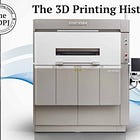Ricoh is returning to 3D printer manufacturing!
The Atomic Layers: S10E3 (00270)
Atomic Layer of the Day:
Ricoh has announced its return to 3D printer manufacturing, with the introduction of a new technology based on material jetting. The technology is enabling the production of full-color resin parts with high mechanical strength and biocompatibility.
While Ricoh is primarily known for its imaging and electronics solutions, the company has been involved in the AM sector for over a decade. Its first attempt to enter the 3D printing market took place between 2014 and 2018, when it offered an SLS system called the Ricoh AM S5500P, designed for industrial applications in the automotive and aerospace sectors.
Despite a promising start, the project was eventually suspended, and Ricoh withdrew from active machine sales, shifting its focus to services and strategic partnerships. In the following years, it established itself as a respected provider of specialized 3D printing services, particularly known for its work in polypropylene selective laser sintering, becoming a kind of authority in this field. The company also developed extensive expertise and FDA-recognized qualifications in the production of medical applications.
For some time, there had been speculation about Ricoh’s potential return to 3D printing hardware. Interestingly, most observers assumed it would involve powder-based systems – either metal or polymer.
Instead, Ricoh has surprised the industry with a resin-based system – a proprietary variation on PolyJet/MJP technologies.
Ricoh’s new technology uses inkjet-based printing with a specially developed resin containing ceramic fillers, significantly improving the mechanical properties of the printed parts. With bending strength reaching up to 180 MPa, this performance far exceeds the typical standards for this class of technology.
Moreover, the optimized formulation of monomers and resins meets the JIS T 10993-1 standards for biocompatibility, paving the way for clinical applications.
The technology has already been implemented at the Core Dental Lab in Yokohama, where it is undergoing testing for use in long-term dental restorations such as dentures and premolar crowns.
The system enables the simultaneous printing of teeth and gum structures in a single process, ensuring natural color transitions and high aesthetic quality.
Ricoh also highlights potential applications in the production of facial epitheses and eyeglass frames, with plans to expand its platform to international markets, including Europe and North America.
There is no doubt that Ricoh’s return to active 3D hardware production is a significant event in the additive manufacturing market, and it marks yet another surprising entry into the material jetting segment, following the recent launch of the Flashforge WaxJet 400.
Atomic Layer from the Past:
05-03-2011: Stratasys acquired Solidscape.
05-03-2016: Formlabs acquired Pinshape – an online 3D printing repository and marketplace.
News & Gossip:
LEAP 71 is scaling its rocket engine development to meganewton thrust levels using its generative software model, Noyron. Two new designs—a 200 kN aerospike and a 2000 kN bell-nozzle engine—will leverage large-scale metal 3D printing. The aerospike test is set for 2026, with the bell-nozzle following in 2029.
The Hamm Institute at OSU has partnered with Divergent Technologies to bring advanced AI-driven manufacturing to Oklahoma. Using Divergent’s DAPS system, the initiative aims to boost defense innovation, create jobs, and position Oklahoma as a national leader in energy-powered industrial production and reindustrialization.
Maxim Lobovsky - CEO of Formlabs, wrote on LinkedIn that their 3D printer sales saw a significant jump in April. Wondering whether this was due to tariffs and Trump’s trade war, he pointed out similarities to the COVID-19 pandemic, during which Formlabs also experienced a comparable increase in sales. This trend was also confirmed by Nico Martin - founder of Canadian Concepts 3D Systems.




